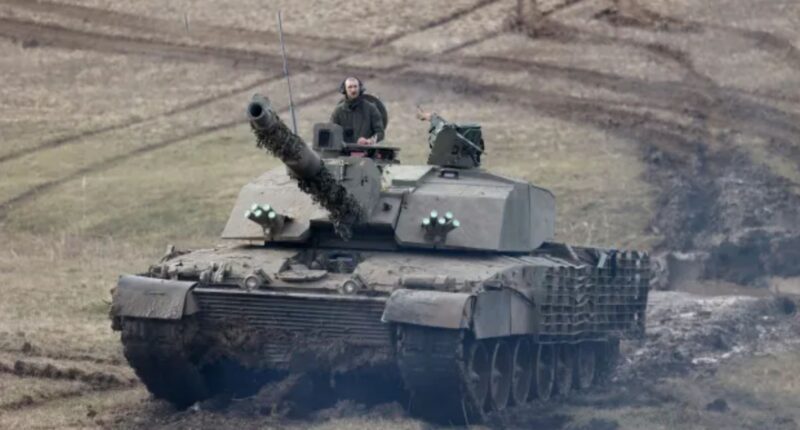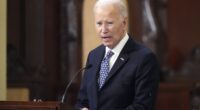BRITISH-made Challenger 2 tanks helped Ukraine break through Russia’s defences in Kursk, according to pro-Kremlin sources.
Russian war bloggers claimed one of the tanks was hit but their reports were not confirmed.




It came as Ukraine surged a mile and a half beyond the Russian frontline in a lightning counter-blitz.
The Ukrainian Armed Forces launched an offensive against the Russian army in various areas, as reported by Kyiv’s Centre for Combating Disinformation (CCD).
Pro-Kremlin war bloggers have claimed that the British Challenger 2 tanks were used in the counter-strike in Kursk.
They also claimed that one of the highly capable Brit tanks was destroyed by a Russian FPV military drone.
Footage showed the strike on what has been claimed to be a Challenger 2 tank in the Kursk region as Ukrainian troops advanced on Putin’s territory.
Telegram war channel Rybar said: “It was destroyed by a drone unit from the 155th Guards Marine Brigade of the Pacific Fleet.”
Dramatic aerial footage later showed an explosion at the suspected Challenger 2 tank.
Despite Russian claims, the crew of the tank was clearly seen escaping in the footage.
And tank did not appear catastrophically damaged by the hit in the drone video.
Britain gave 14 Challenger 2 tanks in March 2023.
One was blown up that summer, but the crew survived.
At least one more was blown up in August in Kursk, with the death of all four crew. It was reportedly hit by a Lancet 3 drone.
Oleg Tsarev, a pro-Putin politician, claimed “less than half” of the Challenger 2s are still in service in Ukraine.
Meanwhile, footage showed Kyiv’s armoured columns roaring over snow-covered fields in paths cut by mine clearance vehicles.
The US-based Institute for the Study of War said Ukraine launched a three-pronged attack and made “tactical advances”.
The CCD also mentioned that Russia expressed concern over Ukraine’s use of long-range missile attacks and electronic jammers to assist their armored assault.
Challenger 2 factfile

THE MoD has claimed the UK’s main battle tank had “never suffered losses” on operations in Bosnia, Kosovo and Iraq.
These 75-ton tanks, valued at £5 million each, surpass the outdated Soviet-era Russian T-55 tanks in terms of speed, armament, firepower, and accuracy.
The Challenger 2’s 120mm gun destroyed an Iraqi vehicle during the Gulf War from three miles away — a “kill shot” record.
They can carry up to 1,800 litres of diesel, giving them an average 341 miles range at a speed of 37mph.
If needed, additional fuel can be sprayed on the hot engine to produce a smoke screen, providing cover in battle.
The 120mm cannon can be armed with armour-piercing shells that fly towards the enemy at 4,250mph.
It can also be armed with high explosive bunker-busting shells that can blow up light enemy vehicles or entrenched positions.
On each side are five smoke grenade dischargers, which can be fired as a smoke screen to the front, protecting against laser beam-riding missiles.
It also has a chain gun spitting out 7.62mm rounds to rip through soft-skinned vehicles such as trucks, or dismounted infantry.
Meanwhile, Ukraine’s surprise attack inside the Kursk region reversed weeks of grinding losses.
Kyiv lost roughly half the 1,000 square kilometres which it seized in a surprise attack in August.
Pictures suggested its troops advanced 1.7 miles towards the town of Bolshoye Soldatskoye on Monday.
Yet the pro-Putin Rybar blog warned the attack was a bluff and the main blow would fall elsewhere.
It claimed Ukraine had been massing troops and electronic warfare weapons which had not yet been deployed.
It said: “There have been rumours that the attack in the direction of Bolshoye Soldatskoye is a diversion, and the main blow may be in another area.
“The main events of the next offensive of the Ukrainian Armed Forces are apparently still ahead.”
America said territory in Kursk was a vital bargaining chip.
Top US diplomat Anthony Blinken said: “Their position in Kursk is an important one because certainly, it’s something that would factor into any negotiation that may come about in the coming year.”
Russian bloggers reported that drones in Kursk stopped working during the offensive due to Ukrainian jamming.
But troops switched to “jamming proof” weapons which are controlled by fibre-optic cables which spool out like fishing lines to keep pilots directly connected.



President Volodymyr Zelensky said his troops managed to counter the oncoming Russian siege on Makhnovka in a move that is said to leave Putin humiliated over the losses.
Zelensky announced on Saturday: “In battles yesterday and today near just one village, Makhnovka, in Kursk region, the Russian army lost up to a battalion of North Korean infantry soldiers and Russian paratroops.”
The heroic leader labelled the losses as “significant”.
Battalions can often vary in size but Vlad is known to throw as many men as he can conjure up into assaults with most being made up of hundreds of fighters.
Vlad has managed to call in over 10,000 reinforcements from his tyrannical pal over in North Korea, claim Ukraine and the West.
This has drastically bolstered his ranks despite many of the foreign fighters being heavily under-trained.
North Korean losses in Kursk are mounting up with Russia using them as cannon fodder and often leaving them unprotected on the battlefield, Zelensky also said last week.
It came as Russia made further gains in Ukraine’s southeastern Donbas.
Moscow claimed to have captured the battleground town of Khurakove as troops continued their march on Pokrovsk, a key road and rail junction in southern Donetsk.
Separately President Zelensky said 3,800 North Korean soldiers had been killed or maimed fighting for Russia.
The casualty figure is almost a third of the 12,000 soldiers deployed by Pyongyang.
Zelensky told podcaster Lex Fridman that Pyongyang could send up to 40,000 more men.
Is Russia’s strategy working?
By Patrick Harrington, Foreign News Reporter
The Russian strategy in 2024 has been to stretch the frontline across a very large distance, which plays to their advantage as the larger army.
However, there has also been a recent step-up in offensive pressure.
Nick Reynolds, a land warfare expert at RUSI, told The Sun the Russians are “no longer just holding the line, but trying to increase pressure” and, although the gains have been incremental, this strategy is working.
In November last year, Ukraine lost more land than any month since September 2022 – with an area almost the size of Greater London falling into Russian hands.
And data released by the Institute for the Study of War shows that Russia gained almost six times as much territory in 2024 as in 2023.
Russia’s latest focus has been Pokrovsk in Ukraine’s southern Donetsk region, where forces have pushed hard for months to claim the city, which had a pre-war population of 60,000.
Over the past few days, Russia has declared victories in villages around 10 miles from the main city, which suggests they are closing in.
Mr Reynolds believes it is only a matter of time until the city is taken – despite Vlad facing “heavy losses”.
He said: “I don’t see anything that can really change at this stage.
“Russia has forward momentum on the battlefield, though it is slow going.
“They are taking heavy losses and they lack the capability to really break the Ukrainian lines, so it is incremental, but it is working.”


















